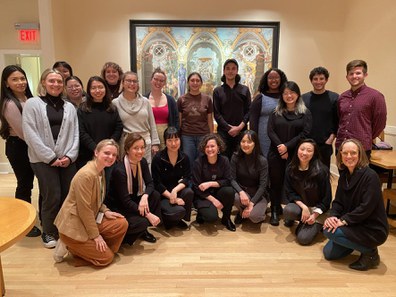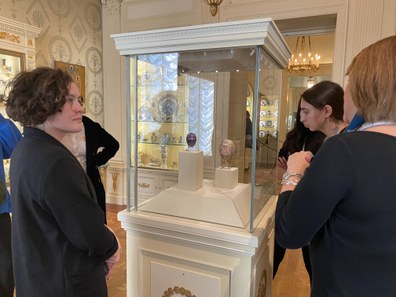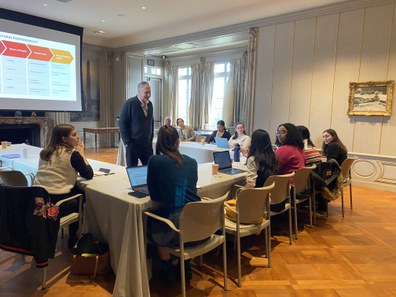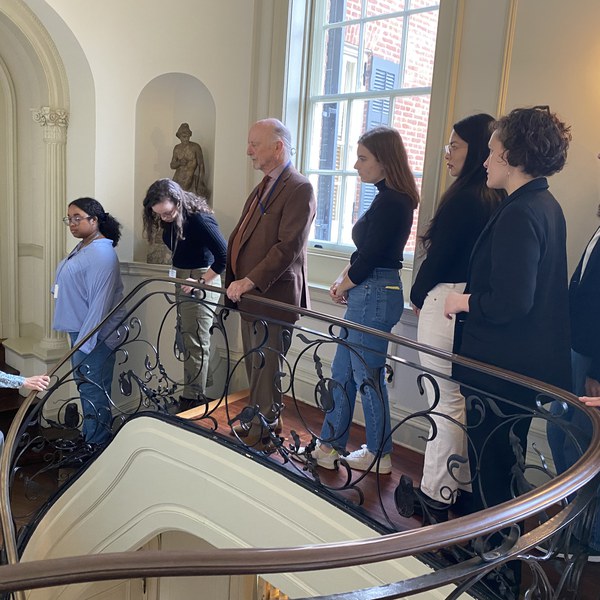
In January, Dumbarton Oaks held its first in-person cultural philanthropy Wintersession since 2020. Cultural Philanthropy in the Museum Space, which we have been offering for the past nine years, takes its students on an intensive examination of financial functions in cultural spaces through lectures, projects, and site visits. To celebrate the longevity of the course and to welcome students back to DC, we redesigned the course and expanded it to a ten-day experience. Eight Harvard undergraduates from an array of academic disciplines participated to learn about the history, relevance, impact, fundraising, and trends of philanthropy.
To reignite and provide a comprehensive and complex grasp of the study of cultural philanthropy, the course brought back celebrated figures and invited new voices in philanthropic scholarship to discuss their research. Additionally, the course paired lectures with visits to six cultural institutions in the Washington metropolitan area to ground conversations in personal experiences.

Two of our longstanding lecturers, Stanley Katz, PhD, former professor of the history of American law and liberty at Princeton, and Kathleen McCarthy, PhD, professor history at the Graduate Center, SUNY, spoke to the history of philanthropy and foundations. Dr. Katz emphasized the legal frameworks for foundations and major donors and left students chewing on the issue of why American cultural spaces need philanthropy to survive. Dr. McCarthy highlighted the work of female philanthropists who often are omitted from philanthropic narratives and opened a line of questioning regarding who is or isn’t credited with philanthropic giving and where can change be seen. In recognition of the role of female philanthropy, Wintersession students traveled to Hillwood Estate, Museum and Garden to view a house museum that was established by Marjorie Merriweather Post. Unlike most museums in Washington, Hillwood was founded by a sole woman donor. Students wandered through Merriweather Post’s home and collection, witnessing her influence during her time and ours.
The idea of donor influence was discussed further when the students traveled to Glenstone, a contemporary art museum in Potomac, MD. The students noted of how it felt to be walking through a private collection that is defined by the founders’ concept of important art. This led to conversations about how there are times when philanthropists are given or assume the responsibility to govern taste through collections or museums. John Wetenhall, Director of the George Washington University Museum and The Textile Museum, expanded upon this dynamic through the example of the role of museum boards. He shared how money and museum expertise do not always align, and that complications can arise when filling a board with donors who are primarily motivated by financial gain.

Amanda Moniz, PhD, the David M. Rubenstein Curator of Philanthropy at the Smithsonian’s National Museum of American History, led the students through the museum’s Giving in America exhibit. She welcomed students to view the expansive historic and contemporary glass-fronted cases of artifacts of philanthropy. Students remarked about viewing objects they have encountered throughout their lives, including donation request letters from foundations and charities, race numbers with corporate sponsorships, donor appreciation gifts of toys, and small personal items.
Wintersession students learned about the process of corporate giving and sponsorships through Michael Bzdak, PhD, Johnson & Johnson’s Global Director of Employee Engagement in the office of Global Community Impact. He shared how corporations contribute to causes and institutions by building and supporting communities as well as their employees. Patricia Banks, PhD, Professor at Mount Holyoke College, also lectured on corporate philanthropy focused on Black community centers, museums, and cultural events. (Banks’s 2022 book, Black Culture, Inc.: How Ethnic Community Support Pays for Corporate America, considers how some corporations’ donations to these institutions may have been motivated by wanting to rewrite or improve their image in American society.) In her lecture Banks noted, by example, the National Museum of African American History and Culture (NMAAHC), which the students visited after her talk. Many of them were surprised to see the number of corporation names engraved throughout the museum space. This prompted the students to reflect on Bzdak and Banks’ discussions about what good a corporation can bring to a community and what good a cultural or community space can bring to a donor.

Furthering the contemplation of the societal benefits of donation, Ben Soskis, PhD, a senior research associate at the Center on Nonprofits and Philanthropy at the Urban Institute, engaged in conversations about ethical giving. Utilizing cases such as the Sackler family, Soskis asked students contemplate the complications that arise when museums accept donor money. George Kosar, Assistant Vice President of Institutional Partnerships at Georgetown University, provided the students with a crash course on fundraising, during which he emphasized the importance of researching potential donors to avoid becoming entangled in a donor’s unsuitable dealings.
The ten-day Wintersession course served up a fresh examination of the many facets of philanthropy. Students interacted with topics through different forms of engagement to gain an impactful look into philanthropy in cultural institutions. And they were asked to apply what they had learned from the various speakers to create a short fundraising pitch, resulting in a number of innovative and strategic plans for cultivating and soliciting donations.
As the course came to an end, the students reflected on how regularly they see philanthropy acknowledged on the sides of buildings, benches and plaques, museum labels, monuments, and as part of career titles. Overall, it’s hard not to encounter the evidence of philanthropy in one’s daily life—and once you begin to notice, you see that philanthropy is everywhere.
Lauren Toman is the postgraduate fellow in cultural philanthropy

